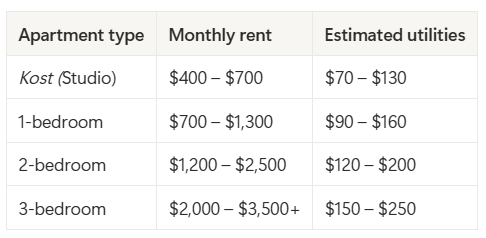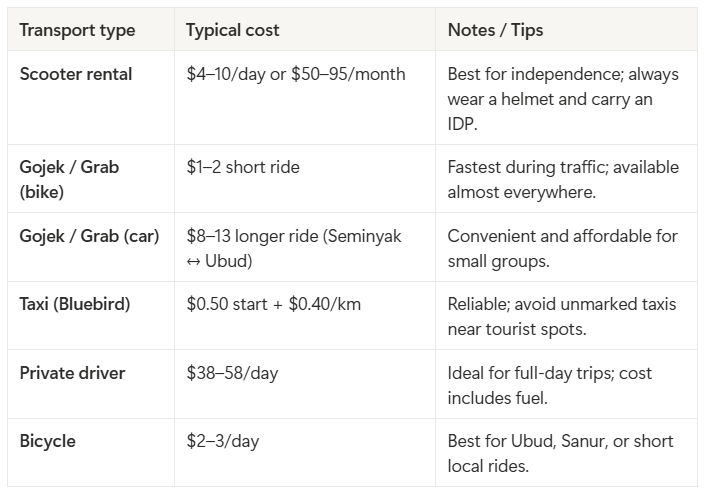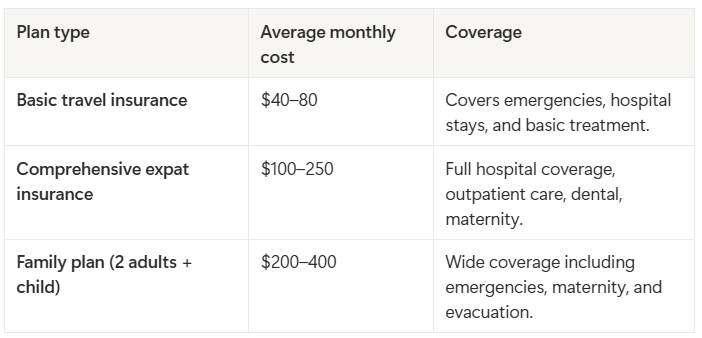

I’ll admit it: Bali is my favourite digital nomad cliché. Laptop by the beach, smoothie bowls, sunset yoga, forests and temples, the zen vibe... It’s the kind of place people visit for a week and end up staying for a year.
But what does life in Bali actually cost? From Canggu’s trendy places to Ubud’s rice field villas, I’ll break down what it really takes to live comfortably in the city, including rent, food, transport, and all the extras that make island life so special.
I think finding a place to live in Bali seems like designing your own slice of paradise. Some people go for a private villa with a pool overlooking the jungle, others prefer a beachside apartment or a small kost tucked between rice fields. Prices differ a lot depending on the area, season, and how long you plan to stay.
Some rentals include Wi-Fi, utilities, and cleaning, while others charge those separately. Long-term leases (usually 6 to 12 months) also tend to be far more affordable than monthly or short-term bookings.
Below, you’ll find the most popular areas for expats and remote workers, from luxury coastal spots to quieter, budget-friendly towns.
Seminyak
Seminyak is Bali’s upscale playground, with stylish villas, rooftop bars, designer shops, and beach clubs that blend sunset views with DJ sets. It’s central, walkable in parts, and perfect if you want both comfort and buzz.
Most rentals are modern villas or serviced apartments with pools, security, and daily cleaning. You’ll pay a premium for convenience and style, but everything you need is within a short walk or scooter ride.

Canggu
Canggu has a younger, surfier vibe, with cafés, coworking spaces, yoga studios, and traffic jams full of scooters. It’s trendy and social, with a mix of modern villas, kosts, and converted rice-field homes.
If you love cafés, sunsets, and surfboards, you’ll fit right in. Just be prepared for occasional flooding, roadworks, and higher prices in hotspots like Berawa or Batu Bolong.

Ubud
Nestled inland among rice terraces and jungle, Ubud is Bali’s calm, creative part. It’s where yoga instructors, artists, and remote workers trade beach bars for quiet mornings and temple bells.
You’ll find plenty of affordable houses and villas surrounded by greenery. Internet can be patchy in rural spots, so always check the connection before signing a lease.

Sanur
Sanur offers a slower, family-friendly version of Bali life. The beach is calm and swimmable, the streets are wide, and it’s one of the few areas where you can cycle comfortably. It’s a favourite among retirees and people who want peaceful mornings instead of late-night beach clubs.
Most homes are single-storey villas with gardens, and you’ll find a strong local community of long-term expats here.

Jimbaran/Uluwatu/Nusa Dua
Down south, life slows down even more. Uluwatu and Jimbaran are known for cliffside villas, surf breaks, and ocean views that look straight out of a postcard. Nusa Dua is more polished, with resort-style living and gated communities.
These areas attract families and professionals who want space and privacy, away from Canggu’s chaos.

Kuta and Legian
Kuta and Legian are Bali’s budget-friendly beach zones, being loud, central, and full of cheap eats, bars, and tourists. It’s not the most peaceful spot on the island, but you can live close to the beach for a fraction of what you’d pay in Seminyak.
Expect older apartments, basic guesthouses, and small kosts. It’s ideal if you’re on a budget or just starting out.

Denpasar
Denpasar is the island’s practical, working city. It’s less glamorous, but close to everything and where many locals and long-term expats live because rent is lower, markets are cheaper, and you can get anywhere in 20–30 minutes by scooter.
If you don’t mind trading beaches for convenience, you’ll find solid apartments and houses at great prices.

Why ranges are wide: Bali has everything from simple guesthouse rooms to private villas with pools. Location, season, length of contract and included services (cleaning, gardener, electricity cap) change prices quickly.
Bali may look small on the map, but getting around can be quite the adventure. The island doesn’t have a metro or train system, so most people rely on motorbikes, taxis, and private drivers. Each option comes with its own perks (and quirks).
Motorbikes/scooters
By far the most popular way to get around, scooters give you full freedom to explore beaches, cafés, and temples at your own pace. Traffic can be hectic, but it’s part of the Bali experience.
Ride-hailing apps (Gojek/Grab)
Apps like Gojek and Grab are life-savers. You can order bikes, cars, or even food and parcel deliveries from your phone. They’re affordable, safe, and widely used by locals and expats alike.
Taxis
Bluebird taxis are the most reliable if you prefer traditional cabs. Always insist on using the meter or agree on a price beforehand to avoid overcharging.
Private drivers/car rentals
If you’re travelling with friends or planning to explore beyond one area, hiring a driver for the day is a comfortable option. Daily rates usually include fuel and waiting time.
Bicycles
Cycling is an enjoyable way to explore smaller areas like Ubud or Sanur, though it’s not ideal for longer distances due to traffic and hills.
Here’s a quick breakdown to help you plan:

Most long-term residents use a scooter for daily errands and Gojek for nights out or rainy days. If you’re new, try hiring a driver for your first week until you get comfortable navigating Bali’s traffic and roads.
Food in Bali is an experience. You can eat like a local at a warung, sip smoothies at a beach café, or enjoy sunset dinners overlooking rice fields. The island will deliver to every taste and price range.
Restaurants
If you’re keeping things simple, local warungs are unbeatable. Expect to pay $2–4 for a filling plate of nasi campur (mixed rice with veggies, meat, and tempeh) or mie goreng (fried noodles). These spots are everywhere and usually serve delicious home-style meals.
Mid-range restaurants and cafés, especially in Canggu, Ubud, and Seminyak, charge around $6–12 per meal, often with trendy settings and Western-style menus (smoothie bowls, salads, grilled fish, and pizzas).
For special occasions, fine dining options like in Uluwatu or Seminyak can go from $60–120 for two people, including appetisers, mains, and drinks. It’s a splurge, but you’re paying for an experience that often comes with ocean views, live music, and impeccable service.
Supermarkets & local markets
Grocery shopping in Bali is a mix of modern convenience and local charm. You’ll find large supermarkets for imported goods, and lively markets for fresh produce and spices. Here’s a comparison:
Tip: Do your weekly haul at Coco Mart or Pepito, get fresh fruits and veggies from traditional markets, and order occasional imports (like cheese or wine) from Bintang or Carrefour. Prices can vary depending on your neighbourhood. Seminyak and Canggu are more expensive than Ubud or Sanur.
Here’s a realistic monthly breakdown in USD:

For one person
Total monthly food budget: $350–600
That’s enough for a comfortable mix of local meals, a few Western indulgences, and some nice dinners by the beach.
For a couple or small family
Total monthly food budget: $650–1,000
Plenty for a mix of home-cooked meals, weekend brunches, and a few splurge nights.
Utilities in Bali are generally affordable, but costs can vary depending on where you live, how modern your place is, and how much you use the air conditioning (spoiler: it adds up fast).
Electricity and water bills tend to be lower than in most Western countries, but many rentals don’t include them, so it’s worth confirming before signing a lease. Most villas and apartments use prepaid electricity (token system), where you top up credit as you go.
Electricity
Electricity is usually charged per kilowatt-hour (kWh), and if you’re running air conditioning daily, expect your monthly bill to climb quickly.
Water
Tap water isn’t safe to drink in Bali, so bottled or filtered water is essential. Most people either order large refillable gallons or install a home dispenser.
Internet
Bali’s internet has improved massively, especially in popular expat areas like Canggu, Ubud, and Sanur. Fibre connections are available in most places, but speed and reliability still depend on the provider and area.
Mobile data
SIM cards are easy to get and cheap. Telkomsel and XL Axiata are the most reliable for coverage across the island.
Here’s a quick breakdown of typical monthly utility costs in USD:

Always check what’s included in your rent before moving in. Villas often charge utilities separately, while kosts and serviced apartments might include Wi-Fi, cleaning, and water in the rent.
Healthcare in Bali is generally good, but it’s one of those things you need to plan ahead for — especially if you’re staying long-term. You’ll find everything from small local clinics for minor issues to high-end international hospitals that feel more like wellness resorts.
Public healthcare
Indonesia has a national healthcare system (BPJS Kesehatan) that locals use, but it’s not commonly chosen by expats, digital nomads, or tourists. Public hospitals can be crowded, slower, and not always equipped for complex or emergency cases.
If you’re visiting or staying short-term, it’s better to use private care. It’s faster, more comfortable, and still relatively affordable compared to Western countries.
Private healthcare
Private hospitals and clinics are where most expats and travellers go in Bali. Many doctors speak English, and some facilities cater specifically to international patients.
Private health insurance
If you’re planning to stay more than a few weeks, having travel or private health insurance is a must. While minor treatments are affordable, serious emergencies, especially those requiring evacuation to Singapore or Australia, can be costly.

Most expats use international providers like Cigna, Allianz, or AXA, which cover treatment in Indonesia and evacuation if needed. For shorter stays, travel insurance from SafetyWing or World Nomads works well.
They say Bali fits every type of traveller, and I say every type of budget too. You can live simply, eat local, and spend your days barefoot in Ubud, or you can go all out with beach clubs, villas, and daily smoothie bowls.
Here’s a rough idea of what life on the island might cost each month.

Bali’s charm is all about balance between work and rest, city buzz and ocean calm. Managing your money while living there is not different.
With Grey, you can send and receive payments in USD, GBP, or EUR, convert them when rates are favourable, and withdraw IDR directly to your Indonesian bank account, speedily and efficiently.
Open your Grey account today to experience truly inclusive global banking, designed for you.




.svg)
Back to top